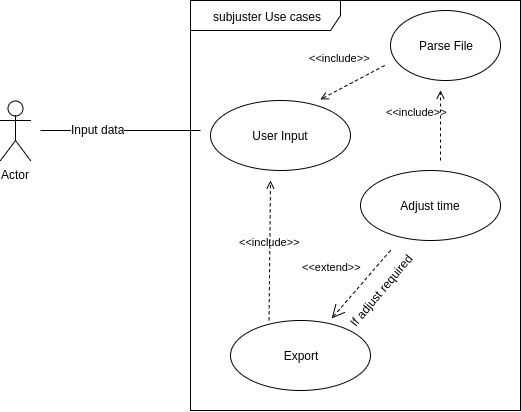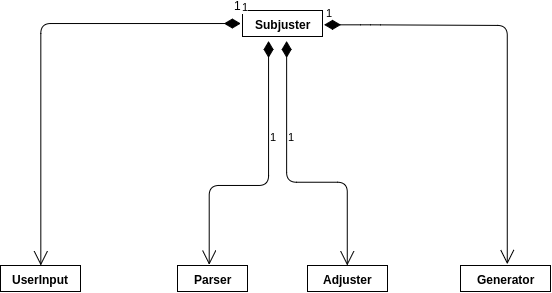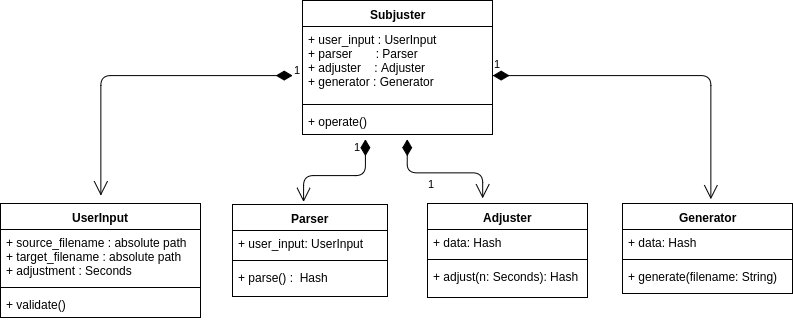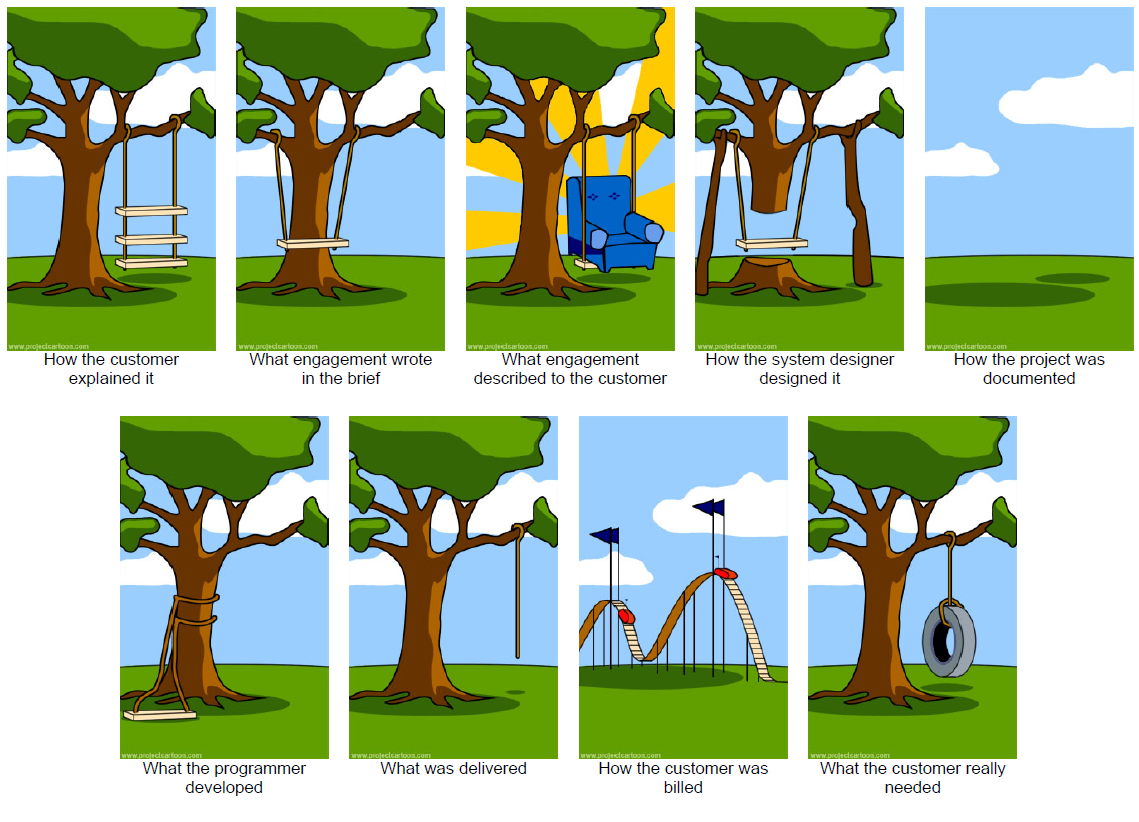Subjuster | TDD guide for Software Engineers in OOP
A Command-Line tool to adjust your movie subtitle files. Its a common issue that while playing movies audio
and subtitle do not sync up. Normally it lags/gains by a few seconds/milliseconds. Using Subjuster
You will be able to adjust and generate a new subtitle file.
Table Of Content
-
[Subjuster TDD guide for Software Engineers in OOP](#subjuster–tdd-guide-for-software-engineers-in-oop) - Table Of Content
- Intention / Purposes
- Installation
- Usage
- Steps to TDD
- Requirement Gathering
- Phase One: UML Drawing and Research
-
[Phase Two Generate a skeleton Ruby gem](#phase-two–generate-a-skeleton-ruby-gem) -
[Phase Three Write expectations from each modules in English](#phase-three–write-expectations-from-each-modules-in-english) -
[Phase Four Write Failing Expectations](#phase-four–write-failing-expectations) -
[Phase Five Write Production Code to Pass Failing Expectations](#phase-five–write-production-code-to-pass-failing-expectations) -
[Phase Five Write_commits_in_steps_for_Parser](/subjuster/tdd_for_parser.html) -
[Phase Six Write_commits_in_steps_for_Adjuster](/subjuster/tdd_for_adjuster.html) -
[Phase Seven write_steps_for_generator](/subjuster/tdd_for_generator.html) -
[Phase Eight write_failing_test_and_make_it_green_for_SubjusterCore](/subjuster/tdd_for_core.html)
- Some rules
Intention / Purposes
I am writing this software and documentation for two of the main reasons
- Teach TDD to emerging Software Engineers
- The problem with new Engineers is, they find the concept of Testing and Specially TDD mind bothering.
- This guide is supposed to guide them via the process.
- Teach little bit of OOP and OOD
Note: If you feel that this doc/repo needs some modifications to help it better meet its purpose, please feel free to send a Pull Request. I would be very much pleased to merge it after reviewing.
If you feel this doc helpful; please don’t forget to put a Star.
Installation
This gem requires
Ruby 2.0+.
$ gem install subjuster
Usage
Usage: subjuster [filename.srt] [options]
Special Case:
subjuster [fiename.srt] -a-12.23 # for -ve number i.e '-12.23'
'+ve' number will add time while '-ve' will decrease.
i.e. if subtitles appears 2 sec after the audio then use '-2' as adjustment
---------------------------------------------------------------------------
-a, --adjustment [Numeric] Time adjustment in sec
-t, --target [Filename] If Target file name not given then will be '[source_file].modified.srt'
-h, --help Prints this help
Example:
$ /movie/path inception_1080p.srt -t corrected.srt -a-12.34
source => inception_1080p.srt
adjustment_in_sec => -12.34
Yeah! successfully adjusted and compiled to file /home/john/corrected.srt
The file is generated in the current working directory.
Steps to TDD
Requirement Gathering
 Before you start a software project,
there should be a problem somewhere in world in the first place; which will you be solving.
You gotta understand everything about the problem as possible.
Before you start a software project,
there should be a problem somewhere in world in the first place; which will you be solving.
You gotta understand everything about the problem as possible.
Next will be, you figuring out ways to solve this problem. You are not supposed to the ultimate solution which is not gonna change ever; It’s not possible, your solution should be robust and always changeable because Requirements always change down the road.
Phase One: UML Drawing and Research
When you’ve thought of solutions, you grab notebook and pen; start making rough sketches(UML diagrams). Think of what your software does and list out separate tasks/actions to perform.
Example(1) of list of tasks you think of:-
- Takes input from the users; may be from CLI or via STDIN(Keyboard)
Inputs will be
filename.srtandnumber_of_seconds| +ve or -ve - Parse the file supplied into some data-structure like
Hash - Modify hash with required adjustments
- Export or Generate the adjusted file to FileSystem.
Now, you draw Use Case diagram if possible. Its simple, go through some online blogs and start drawing. After that, you need to draw Class Diagram. This is necessary to figure out what components your software is gonna composed of.
Lets do it: Extract out nouns from the list in Example(1).
- UserInput
- Parsertoc
- Modifier / Adjuster
- Exporter / Generator
Rule: According to
Single Responsibility Principle(SRP)of Object Oriented Design fromSOLID, one class/module/function should not take more than one responsibility.

We complied to the rules and decided to have 4 modules doing individual tasks and collaborate with each other sending messages. Now we draw Class Diagram of our first thought.
Brief Class Diagram

Question: What is this
SubjusterorSubjuster::Coremodule doing here?
This module is a wrapper to tie your application components together like Namespace. This module will facilitate your application; which we will cover in later topics.
Read this document in Class Diagrams and learn the meaning of arrows and boxes. This will help you in you career as well. Keep in mind that you don’t have to learn UML and gain expertise to learn TDD; you only have to be able to draw boxes and name them. You can use Draw.io to draw UML diagrams; it’s open source and free.
Detail Class Diagram

Is it complicated?
If you feel lost, then no worries, forget about the relationship between modules; we will learn later. For now, focus on the boxes and its properties.
Phase Two | Generate a skeleton Ruby gem
We at the end are going to release this project as a standalone gem so that
any one willing to use this can get benefit from this.
Following is command to generate a new gem skeleton using bundler.
$ bundle gem [subjuster]
The name of gem can be anything in your case. This command generates a bundler compatible gem skeleton which you can modify and build your idea.
Note: If you are not comfortable with
gemsthen, simply follow the folder structure in this repo. You will get hang of it soon.
Phase Three | Write expectations from each modules in English

It’s not possible for everybody to figure out which technique are you gonna use to implement that particular function in code before hand. Therefore, think of what you expect from that particular feature in English. You already know what to expect from that module/function, don’t you?. If you are confused then go ask your product owner about the requirements.
Lets write some expectations in pure English:-
1. UserInput
- Should take `source_filepath` as argument while construction
- Should take `target_filepath` as argument while construction
- Should take `no of seconds` to be adjusted as argument while construction
- Should be able to validate the inputs
- `source_filepath` should be valid
- should be a valid `.srt` file
2. Parser
- Should take `user_input` as params
- Should able to parse the valid `srt` file
- `parse()`
- Should return a `hash` of subtitle
- hash should have `start-time` and `end-time` of every dialog in the hash
3. Modifier / Adjuster
- Should be able to take the `Hash` containing `srt data-structure`
- `adjust(no_of_seconds)`
- Should return the modified version of `Hash` supplied
- Should be able to adjust the srt `Hash`'s `start-time` and `end-time` by `+2` seconds if `+2` is passed as argument
- Should not adjust the srt `Hash`'s `start-time` and `end-time` by `-2` seconds if `+2` is passed as argument
4. Exporter / Generator
- Should accept `Modified Hash` as argument
- `generate(target_filepath)`
- Should be able to generate a valid `.srt` file to the path asked
This pure english can easily be transferred to RSpec’s DSL. See this file subjuster_spec.rb. I have already prepared the Pure English version of Test Cases using RSpec’s DSL. Now we need to put assertions to verify the usability of the modules. We will see that in next section.
Glimpse of Specs
describe UserInput do
it 'Should take `source_filepath` as argument while construction'
it 'Should take `target_filepath` as argument while construction'
it 'Should take `no of seconds` to be adjusted as argument while construction'
context 'Should be able to validate the inputs' do
it '`source_filepath` should be valid'
it 'should be a valid `.srt` file'
end
end
Defining TDD in simple language
 It’s like signing a contract with everything
It’s like signing a contract with everything needed to be done specified in formal language. This is needed to define the Job Done. We write test-cases before implementing a feature; which will let us know when that particular feature/function is done, so that we can move on to next function. It will help you stick with the features client/owner demanded. Often developers lose track of what they should be doing in that iteration.
Phase Four | Write Failing Expectations


Firstly, we do some cleaning; we separate out specs related to individual module to corresponding spec files, like, user_input_spec.rb will contain specs only related to UserInput module and so forth.
Now, we use our knowledge of Ruby and little bit of RSpec DSL. We pick one module at a time, because we are on war. We write expectations that we know it should fail because they are not yet implemented. I am implying syntax errors as well by failing test. It can be Class not defined kinda error though. The errors are intended and expected.
In the beginning we pick the simplest module i.e. UserInput. Its legit to go in sequence.
In the file user_input_spec.rb we pick the top most expectation i.e.
it 'Should take `source_filepath` as argument while construction'
Now after putting an expectation it looks like:
it 'Should take `source_filepath` as argument while construction' do
source_filepath = '/tmp/source_file.srt'
expect(UserInput.new(source: source_filepath).source_filepath).to eq(source_filepath)
end
While running the command rspec spec/ I encounter this error
NameError:
uninitialized constant `UserInput`
Finished in 0.00022 seconds (files took 0.40604 seconds to load)
0 examples, 0 failures, 1 error occurred outside of examples
Error is Good.
To comply with our requirements, there should be a class UserInput in the first place. This technique is also called Error Driven Development. Errors and failure will guide you to the destination; a better tomorrow.
Little improvisation needed here; We need to use Subjuster namespace to
bind modules in a box. Lets create a file called
lib/subjuster/user_input.rb where our class
UserInput will be defined. And, in lib/subjuster.rb
we will require the file so that RSpec could load the file in test-suites. Also will use
Subjuster::UserInput instead of just UserInput.
Phase Five | Write Production Code to Pass Failing Expectations
 Next thing you do is, define the class
Next thing you do is, define the class UserInput.
Rule: You deal with one RED/Failing test at a time; you take that examples from Red –> Green; then only you touch next example/test-case.
# lib/subjuster/user_input.rb
module Subjuster
class UserInput
end
end
Now see the execution result:-
$ rspec spec/user_input_spec.rb
ArgumentError:
wrong number of arguments (given 1, expected 0)
# ./spec/user_input_spec.rb:6:in `initialize'
# ./spec/user_input_spec.rb:6:in `new'
# ./spec/user_input_spec.rb:6:in `block (2 levels) in <top (required)>'
It means we are advancing, we surpassed our first error and now in second. It says, may be we have not defined the initialize function with proper arguments. So, we obey the suggestion.
module Subjuster
class UserInput
def initialize(source:)
end
end
end
Now see the execution result:-
$ rspec spec/user_input_spec.rb
NoMethodError:
undefined method `source_filepath` for #<Subjuster::UserInput:0x0056444cadabd8>
# ./spec/user_input_spec.rb:6:in `block (2 levels) in <top (required)>'
Now, we need to define the getter method source_filepath
module Subjuster
class UserInput
attr_reader :source_filepath
def initialize(source:)
end
end
end
Now see the execution result:-
$ rspec spec/user_input_spec.rb
Failure/Error: expect(Subjuster::UserInput.new(source: source_filepath).source_filepath).to eq(source_filepath)
expected: "/tmp/source_file.srt"
got: nil
(compared using ==)
# ./spec/user_input_spec.rb:6:in `block (2 levels) in <top (required)>'
It means, still the mill/function source_filepath is not functional. Now lets set instance var @source_filepath. Then, may be it will work.
attr_reader :source_filepath
def initialize(source:)
@source_filepath = source
end
Now see the execution result:-
$ rspec spec/user_input_spec.rb
Finished in 0.00242 seconds (files took 0.26666 seconds to load)
5 examples, 0 failures, 4 pending
Hurrah! we did it. We made the Red test-case to GREEN.
Now, you can repeat the same process for Parser.
This process should be repeated till you are done with all the features. Please see the individual files in spec/ and lib/subjuster as references.
If still you need assistance then see the documentation in /tdd_for_parser.md.
Phase-5 Write_commits_in_steps_for_Parser
Phase-6_Write_commits_in_steps_for_Adjuster
Phase-7_write_steps_for_generator
Phase-8_write_failing_test_and_make_it_green_for_SubjusterCore
Some rules

- If you are stuck and could not test your module then
- may be your module is trying to do a lot of things; recall SRP(Single_responsibility_principle)
- may be you need to break your module down to multiple modules
- Write Production code for one red-test case at a time
- Unless business requirement changes, you are not allowed to change tests to pass them.
- Only write code sufficient to pass the test; not a word more.
- DO NOT do refactoring unless covered with rigorous test-specs
- First solve problem in way you can; do not waste time to think about the best-way possible.
- when you have your test-suite GREEN then you start Optimizing the solution.
- There is always way to optimize your code; but is it worth it?
